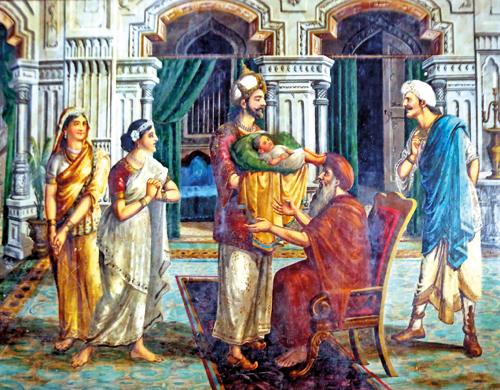Isipathanaramaya: City temple with a window to 1920s Ceylon
 Isipathanaramaya in Havelock Town is one of the oldest temples in Colombo – a Buddhist beacon with the precincts housing the biggest stupa (120 ft tall) within Colombo, and a Bo tree that is more than two hundred years old.
Isipathanaramaya in Havelock Town is one of the oldest temples in Colombo – a Buddhist beacon with the precincts housing the biggest stupa (120 ft tall) within Colombo, and a Bo tree that is more than two hundred years old.
This Poson the temple was quite busy and as the Chief Incumbent the Ven. Waga Vijitawansa Thera said, devotees flocked for sil while the daham pasal hosted a soup dansal in the temple and the dayakayas a cool drinks dansal at Mihintale.
The murals within the image house, done by well-known painter Maligawage Sarlis, one of Ceylon’s first ‘professional’ painters who mixed with a sensitive brush Western realism and his own imagination of what the India of the Buddha’s time may have been like, draw visitors all year round.
Considered a landmark, Sarlis’s murals are among the oldest examples of a new style of temple painting and sculpture that was to emerge in the early 20th Century; the prototype that was to be much copied even up to this day.
From the cool darkness of the interior, gaze out pantheons of deities, demons, imps, makaras, lions rampant not unlike the British lion and maybe even unicorns (it’s impossible to notice everything in the throng of painted beings soaring ceiling-wards). Rococco details fill every tiny corner of the high ceiling and walls reminding one of a Florentine villa or chapel.
The temple, serene with the soft susurration of Bo leaves, had its beginnings in a tragedy that shook the island: the bloody execution by the colonial rulers of 26-year-old Captain Henry Pedris at 6 a.m., on July 7, 1915. His father D. D. Pedris, one of the wealthiest men of his time built the temple in this residential suburb in memory of his son.
Educated at the Colombo Academy (as Royal College was then known) and S. Thomas’ College, young Henry had a promising future ahead of him, and was the first Sinhalese to be enlisted to the Colombo Town Guard. Soon promoted to the rank of Captain, he was the envy of local officials.

Vihara-ge: Sarlis's epic murals of the life of the Buddha cover every surface. Pix by M.A. Pushpa Kumara
Even though the role he played in the Sinhala-Muslim riots of 1915 was that of a mediator (it was he who successfully managed to disband several rioting groups after peaceful discussions), some raised false charges that he had shot at Muslims and incited people to march to Colombo. He was charged with treason, shop-breaking, attempted murder and wounding with intent to murder.
Executed by firing squad, his funeral was held under martial law at midnight, his body not handed over to his family, and his burial not recorded in any official register.
Though his execution was intended by the British as a warning to the middle classes struggling for independence it served the opposite purpose. It is, in fact, viewed as the beginning of the movement that was to culminate in independence for the island from 150 years of British rule in 1948.
The Isipathanaramaya temple was built in 1916 and a library in the premises has in addition to an impressive array of books, portraits of the Pedris family for those who may be interested in its history. Most however are drawn to the vihara-ge where the paintings are so intricate you can linger for hours perusing the detail on floral bouquets to scenes from the life of the Buddha.
While the Buddha’s life is told on the walls the high wooden roofs have pictures of shrines like Ruwanweli Seya and Jetavana, clad in jungle as they were in the 1920s.
The murals done from 1920 to 1921 did not live up to the expectations of certain Western-educated intellectuals, for whom this hybrid style was far from being a worthy heir to the traditional temple art of Sigiriya, Polonnaruwa or Kandy.
But writing in his personal blog, Peter Schoppert (Director of the Publishing House NUS Press), defines the new school as ‘exuberant, theatrical re-castings of the traditional subjects of Buddhist temple art’.
Whether it is a rendering of the noblewoman Sujata offering alms to the Buddha (with the saree worked intricately) or Prince Siddhartha leaving his lay life (with a gorgeously caparisoned horse) the details are rich, ornate and colourful– the ‘garlands and bouquets and halos and aureoles’ alone prompting Schoppert to compare it to Villa Farnesina in Rome.
Schoppert also comments on the relationship between the painted sculptures and their backdrops. While the sculpted figures gleam with thick colour, the backdrops are much softer (‘a more academic realist style’, says Schoppert).
Today this vibrant yet tranquil temple with its sculptures and art is a window to a world of 1920s Ceylon where there was a very illuminating new interest in Buddhism, and of course the world of Gautama the Buddha, for Sarlis’s brush has some ingenuous ability to bring it all alive – prince, deity, hermit and demon.
Searching for an ideal partner? Find your soul mate on Hitad.lk, Sri Lanka's favourite marriage proposals page. With Hitad.lk matrimonial advertisements you have access to thousands of ads from potential suitors who are looking for someone just like you.


